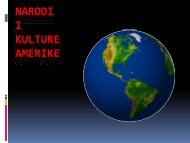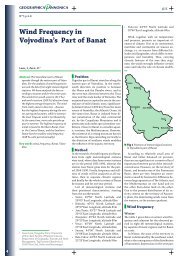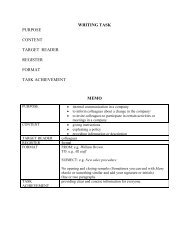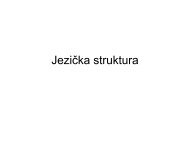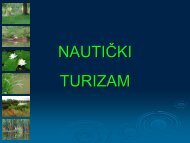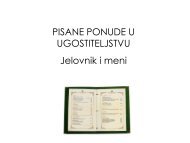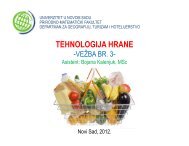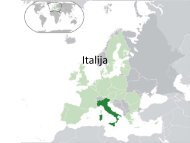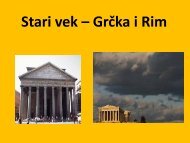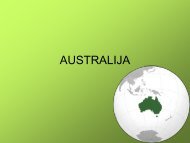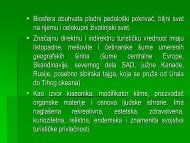Petrovaradin Fortress (Novi Sad, Serbia): Tourism Spatial Planning ...
Petrovaradin Fortress (Novi Sad, Serbia): Tourism Spatial Planning ...
Petrovaradin Fortress (Novi Sad, Serbia): Tourism Spatial Planning ...
Create successful ePaper yourself
Turn your PDF publications into a flip-book with our unique Google optimized e-Paper software.
TURIZAM<br />
Volume 15, Issue 2<br />
65-76 (2011)<br />
Abstract<br />
Introduction<br />
<strong>Petrovaradin</strong> <strong>Fortress</strong> (<strong>Novi</strong> <strong>Sad</strong>, <strong>Serbia</strong>):<br />
<strong>Tourism</strong> <strong>Spatial</strong> <strong>Planning</strong> and Design<br />
of The Upper Town for the Function of<br />
Cultural <strong>Tourism</strong><br />
Vuk Garača*<br />
Gordana Jovanović*<br />
Lolita Pejović*<br />
Received: December 2010 | Accepted: May 2011<br />
The <strong>Fortress</strong> consists of several spatial entities, among which the Upper Town is the most attractive and the<br />
most developed one. Cultural and tourist-catering contents should have a primary function of the space,<br />
which would enable the <strong>Fortress</strong> to become the gathering place and the centre of cultural tourism in a wider<br />
area. One of the most important questions refers to the way of management of this cultural value while one<br />
of the most appropriate solutions is establishment of a special public enterprise. Intensive development of<br />
tourism implies special conditions for the protection and preservation of the <strong>Fortress</strong>. The topic of this work<br />
is <strong>Petrovaradin</strong> <strong>Fortress</strong>, i.e. the Upper Town and its tourist organization in the function of cultural tourism.<br />
This work is aimed at presenting the possibilities that this area has for the development of tourism with a special<br />
accent placed upon cultural tourism. The tasks of this work are to present suggestions for tourist organization<br />
of this area with necessary urban equipment and for enrichment of museum and gallery objects with<br />
additional contents as well as the establishment of completely new exhibitions.<br />
Key words: tourism spatial planning and design, cultural tourism, <strong>Petrovaradin</strong> fortress.<br />
<strong>Petrovaradin</strong> <strong>Fortress</strong> is located on the area where tourist zones of the Danube and Fruška<br />
Gora Mountain overlap and where the Danube represents the zone of international rank<br />
of the 1st degree. Consequently, <strong>Fortress</strong> in intended to host, apart from tourist objects and<br />
* University of <strong>Novi</strong> <strong>Sad</strong>, Faculty of Sciences, Department of Geography, <strong>Tourism</strong> and Hotel Management, Trg<br />
Dositeja Obradovića 3, 21000 <strong>Novi</strong> <strong>Sad</strong>, <strong>Serbia</strong>;<br />
Corresponding author: vuk.garaca@dgt.uns.ac.rs<br />
65
areas, contents from the field of education, culture, tourism and recreation such as: art academy,<br />
ateliers, summer stages, planetarium, hotels and similar (Geographical <strong>Spatial</strong> Organization,<br />
2001). The area of <strong>Petrovaradin</strong> <strong>Fortress</strong> with the Lower Town is defined as the<br />
main, primal centre of the development of tourism on the area of <strong>Novi</strong> <strong>Sad</strong>. The structure of<br />
the contents that will develop in the centres is determined according to the importance of<br />
the centre, the role it has in the system of centres and specific conditions. <strong>Petrovaradin</strong> <strong>Fortress</strong><br />
should become a cultural-historical, recreational, tourist and catering centre. As such,<br />
<strong>Petrovaradin</strong> <strong>Fortress</strong> with the lower Town will develop according to special programmes<br />
while its space will be maintained within the system of protection (Rakić, 2004). The status<br />
of <strong>Petrovaradin</strong> <strong>Fortress</strong> is regulated by the Law on cultural goods that was adopted in 1994<br />
by the Government of the Republic of <strong>Serbia</strong>. It is described as an immobile cultural good<br />
of great („Službeni list R. Srbije“ br. 71\94). The previous act, made by the Executive Council<br />
of the Autonomous Province of Vojvodina, determined that the Upper and Middle <strong>Fortress</strong><br />
with the Lower Town, i.e. <strong>Petrovaradin</strong> <strong>Fortress</strong> as an entity and all objects on it, represent<br />
an immobile cultural good, i.e. spatial cultural and historical entity of great importance<br />
(“Službeni list AP Vojvodine” br. 25/91).<br />
The topic of this work is the Upper Town of <strong>Petrovaradin</strong> <strong>Fortress</strong> and its planning,<br />
organization and management in the function of cultural tourism and its very development.<br />
The work will deal with the problems of tourism spatial planning and design in the Upper<br />
Town of <strong>Petrovaradin</strong> <strong>Fortress</strong>, way of planning and exploitation of this area and partially<br />
Figure 1 Position of the <strong>Petrovaradin</strong> fortress on the Danube River in <strong>Novi</strong> <strong>Sad</strong><br />
Scale: 1:20.000<br />
66 TURIZAM | Volume 15, Issue 2, 65-76 (2011)
Key Attributes<br />
with the way of its management. This work is aimed at presenting the possibilities that this<br />
area has for the development of cultural tourism due to its cultural and historical heritage<br />
which represents a potential driving force of development, opening of new working places<br />
and achieving extra profit, which would be used for reconstruction, conservation and revitalization<br />
of destroyed and neglected parts of the <strong>Fortress</strong>. The tasks of this work are strictly<br />
connected to scientific-research process and methodological postulation of this work. The<br />
primal task is studying of the existing situation on the field, taking critical position concerning<br />
the given situation, giving suggestions for tourist organization of this area with necessary<br />
urban equipment, giving suggestions for the change in the function of certain objects or<br />
their parts as well as enriching and innovating the contents in the observed area.<br />
<strong>Tourism</strong> spatial planning and design is a planned and conscious activity represented by the<br />
scope of different economic and non economic activities, aimed at planning, creation, management<br />
and organization of infrastructural sub structural objects, services and personnel<br />
dedicated to tourists and based on previously determined scope of demand, potential of offer,<br />
socio-economic goals of society and local community. From all of concepts that create what<br />
we call tourism spatial planning and design, we will discuss in this work those concepts that<br />
refer to devices and equipment in the function of tourism spatial planning and design, sustainable<br />
development, cultural tourism, planning and management so that the process of<br />
tourism spatial planning and design is made completely clear.<br />
Devices and equipment in the function of tourism spatial planning and design<br />
<strong>Tourism</strong> spatial planning and design denotes general and communal city organization that<br />
includes establishment, maintenance and protection of urban and communal equipment or,<br />
as it is referred to by many authors, general and communal infrastructure (Jovičić, 2002;<br />
Laws, 1995; Krippendorf, 1982; World Tourist Organization, 1980). General city organization<br />
implies conditions and way of establishing, maintenance and protection of urban<br />
mobiliar, objects and equipment on public surfaces; organization, use and maintenance of<br />
public areas; organization and maintenance of outer parts of the buildings (Zakon o planiranju<br />
i izgradnji, 2006). Communal organization of one city implies conditions and manner<br />
of establishment, maintenance and protection of communal objects as well as conditions<br />
for performing the activities that they belong to: public advertising, maintenance of street<br />
lightening, lightning of objects and festive city decoration, maintenance of public restrooms<br />
(Odluka o uređenju grada, 2006).<br />
Sustainable development of tourism<br />
<strong>Tourism</strong> is the product of space, it exists in space and influences the transformation of space<br />
(Kripendorf, 1982), which very often uses those objects and areas that are not interesting to<br />
a number of other activities. However, their degradation may cause a serial of conflict situations<br />
while tourist potential disappears and tourist activity is disabled (Stanković, 1998).<br />
TURIZAM | Volume 15, Issue 2, 65-76 (2011) 67
Cultural tourism<br />
When we speak about the sustainability of one destination, it should be emphasized that it<br />
represents its capability, that it keeps the quality of its physical, social and cultural environment<br />
while at the same time it competes with its own products on the market (Ritchie,<br />
Crouch, 2003). The concept of sustainable tourism is based on three supporting columns<br />
of sustainable development, which were defined and recommended by the World Tourist<br />
Organization. These are: sustainability of economic, cultural and natural surrounding.<br />
World Tourist Organization states and warns that the development of sustainable tourism is<br />
possible only if all the relevant factors are thoroughly informed and included in the process.<br />
On the other hand, sustainable tourism must maintain the high level of tourist satisfaction,<br />
provide consciousness of the surrounding and lead active promotion of sustainable tourism<br />
(Mihalič, 2006).<br />
Previously mentioned factors refer to one new category of sustainability and that is the<br />
concept of supporting capacity. It gathers all ideas of sustainable development of tourism<br />
and appears as the unique function of sustainable development. That means that supporting<br />
capacity can be observed as well as the maximum number of visitors who use certain area<br />
without any negative consequences and decline in the quality of tourist experience (Mathieson,<br />
Wall, 1982). Consequently, supporting capacity represents the mean in the organization<br />
of tourism that, by the reduction in the number of tourists, prevents endangering of natural<br />
and cultural values of one tourist destination (Stojanović, 2006). Supporting capacity is<br />
manifested through four capacities that define certain segments of the sustainability of one<br />
entity. These segments are so elemental that must represent the base for every long-term plan<br />
of tourist development in certain area or destination. The supporting capacities are the following:<br />
ecological, social, psychological and economical (Jovičić, Dragin, 2008).<br />
If tourism is developed according to a plan in certain area, it can not have a negative influence<br />
on the space but can only encourage the actions aimed at protecting natural and anthropogenic<br />
values that it valorises (Stanković, 1991) and more than other activities avoids collisions<br />
and encourages elements of complementary development (Stanković, 1996). <strong>Tourism</strong><br />
should educate, promote and raise interest among tourists in the space they visit and at the<br />
same time promote responsibility and raise conscious of sustainability in general. It is necessary<br />
to emphasize that tourism represents educational component of this type of tourism is<br />
its key aspect and that tourist are keen on learning, seeing, doing and participating (Vistoria,<br />
2006). It is cultural tourism that is recognized as a new market and a new form of tourism<br />
that remains forever (Richards, 2001), as a special interest in tourism itself (Douglas and<br />
Derrett, 2001) and as a special market niche with growing demand (Jansen-Verbeke, 1996).<br />
This is how cultural tourism is used, apart from the other, for positive promotion of culture<br />
and cultural heritage (Light, 2000). Consequently, this kind of interacting relationship<br />
between culture and tourism brings a wide correlation and mutual interest that is confirmed<br />
with the creation of extra income in favour of both the activities and causes sustainability<br />
and promotion of cultural resources that would otherwise disappear (Hughes, 2000). The<br />
important fact is that cultural tourism represents a widely spread phenomenon and activity<br />
that creates conditions for a wide range of activities. Cultural tourism protects cultural heritage,<br />
promote it (Çalışkan, 2010) and places it in the function of different musical, dance<br />
or theatre events (Hughes, 1998). The importance of cultural heritage as a tourist destina-<br />
68 TURIZAM | Volume 15, Issue 2, 65-76 (2011)
tion lies in the fact that it offers possibility for attracting visitors (Richards, 2002), as well as<br />
branding and promotion destination (Medica, Ružić, Ružić, 2010).<br />
Management of tourist area<br />
When we talk about tourist destination, we usually imply more or less encircled geographical<br />
entity that features a number of attractive, receptive and communication factors (Jovičić, 2002;<br />
Bakić, 2002), or we think of the notion of the management of tourist destination, i.e. way of<br />
managing a certain space intended to be used by tourists. In that sense, it is necessary to determine<br />
the mission and directives for the development of destination, i.e. cultural tourism at the<br />
destination (Hadžić, 2005), as specific tasks in its development. In order for a destination to<br />
develop successfully, it is necessary to create the strategy of the management of tourist destination,<br />
where planning represents the first and maybe the most important phase in the process of<br />
management (Čerović, 2003; Milisavljević, Todorović, 1991, Mulec, 2010). Moreover, strategic<br />
management of tourist destination represents the choice of an appropriate direction that will provide<br />
tourist destination with a competitive position on a tourist market, lessen or increase its sensitivity<br />
towards changes and accomplish defined business goals. System theory, which includes<br />
the relationship between long-term, middle-term and short-term plans, provides a frame within<br />
which it is possible to plan and predict both nearer and further consequences and at the same<br />
time, allow less painful redefinition of the plan (Bakić, 2002; Dulčić, 2001).<br />
Background Facts<br />
The Upper Town is built as the central and the most important part of the <strong>Petrovaradin</strong> <strong>Fortress</strong>,<br />
and it spreads over 6.33 ha, that is 7.91% of the overall fort space. It is the smallest section<br />
of the <strong>Fortress</strong> by its surface, but, by its function and arrangement, it is the <strong>Fortress</strong>’s<br />
most important part. The main functions of the Upper Plateau are culture and the hospitality<br />
industry in the function of tourism. As far as the cultural offer is concerned, there are<br />
the City Museum of <strong>Novi</strong> <strong>Sad</strong>, the City’s Historical Archive, planetarium and artist’s studios,<br />
while the main representatives of the hospitality industry are the “Leopold” Hotel, three<br />
restaurants, one with national and two with international cuisine, the offices of the Protocol<br />
of <strong>Novi</strong> <strong>Sad</strong> and the “Muzej” Club (Popović, 1996). The most significant objects of the whole<br />
<strong>Fortress</strong> are situated in the Upper Town. They are all from the 18th century; they are all one-<br />
Table 1 Review of the Upper Town Objects’ Surface<br />
Number Object’s name Surface (m 2 ) Percents (%)<br />
1 Long Barracks 7,073 45.6<br />
2 Arsenal 3,830 24.7<br />
3 Simple Barracks 2,045 13.2<br />
4 Officer’s Pavilion 1,650 11.0<br />
5 Bakery 632 4.1<br />
6 Powder Magazine 284 1.8<br />
7 Overall 15,514 100.0<br />
Source: Popović, 1996.<br />
TURIZAM | Volume 15, Issue 2, 65-76 (2011) 69
storey or single-storey buildings with sloping roofs covered with traditional types of tiles,<br />
which is the characteristic of baroque buildings (Marković, 1996).<br />
The table shows the surface of the Upper Town objects. It can be noticed that, according<br />
to surface, the objects are very different – the biggest object, the Long Barracks, is 25 times<br />
bigger than the smallest one, the Powder Magazine. That proves the diversity of facilities<br />
built in the Upper Town, which gives the opportunity of various offers different in terms of<br />
both function and quantity, and provides the wide range of possibilities for the quality planning,<br />
organizing and arranging of this part of the <strong>Fortress</strong> in the function of tourism.<br />
Table 2 Review of the Upper Town Objects’ Surface according to contents and users in m²<br />
Number Object’s name User Surface (m 2 )<br />
1 Long Barracks Hotel “Leopold” 5,324<br />
2 Officer’s Pavilion Restaurants and Protocol 850 + 800<br />
3 Arsenal City Museum 2,355<br />
4 Simple Barracks City Archive 1, 614<br />
5 Bakery under renovation 632<br />
6 Powder Magazine City Archive 284<br />
7 Overall - 11,859<br />
Source: Popović, 1996.<br />
The table shows the areas of primary users of the objects in the Upper Town. When compared<br />
to overall area of surface objects it makes 76.44%. It should be emphasized that there<br />
is a great difference between all the built and used areas which makes 3.655 m² or 23.56%<br />
of the overall built surface. It can be concluded that a significant part of built areas is completely<br />
unused and that there is enough space for new tourist contents. Moreover, the fact is<br />
that significant areas of built space are used by non tourist contents which do not contribute<br />
to the attractiveness of the area or have any financial effects on the maintenance of the<br />
Upper Town. These are <strong>Novi</strong> <strong>Sad</strong> Archive, almost 70% of the City Museum of <strong>Novi</strong> sad and<br />
Protocol which together cover over 5,000 m², i.e. 32.57% of the most attractive objects in<br />
the Upper Town.<br />
The Upper Town in the past had a much dense structure, i.e. more objects and more users<br />
of the same. It should be emphasized that it is a rather disturbing data that there are four<br />
objects missing in the Upper Plateau that were destroyed in the period between 1918 and<br />
1952 with the purpose of functional organization of this area (Marković, 1996).<br />
Table 3 Review of objects and surfaces that are planned for reconstruction (in m²)<br />
Number Object’s name Dimensions Base surface Effective surface<br />
1 Big Guard House 14x20 280 560<br />
2 Transport Barracks 10x40 400 800<br />
3 Engineering Barracks 10x23 230 460<br />
4 Artillery Barracks 11x40 440 1.320<br />
5 Part of Simple Barracks 11x11 121 363<br />
6 Overall - 1,471 3,503<br />
Source: Rakić, 2004.<br />
70 TURIZAM | Volume 15, Issue 2, 65-76 (2011)
Figure 2 View on the <strong>Petrovaradin</strong> fortress from the <strong>Petrovaradin</strong> (east) site<br />
Source:http://www.grid.uns.ac.rs/dokumenti/simpozijum/10/images/venue/petrovaradinska_tvrdjava.jpg<br />
Figure 3 Detailed plan with an overview of objects, bastions and streets in the Upper Town<br />
Phases of the Research<br />
Few different phases were used in the course of the research process: (1) Indoor research and<br />
(2) Field research.<br />
Indoor research<br />
This part of the research implies the study of primary and secondary built (Xie, 2006). This<br />
phase provided data from town planning and area planning documents. Those are actually<br />
data that describe the purpose of the observed area in general when the general town plan of<br />
<strong>Novi</strong> <strong>Sad</strong> is concerned or data that describe specific objects when the detailed town plan is<br />
concerned. Moreover, we also used sources such as regulations, laws and decisions that had<br />
a direct influence upon this area and its development in the sphere of tourism.<br />
TURIZAM | Volume 15, Issue 2, 65-76 (2011) 71
Field research<br />
Field research is an inevitable one, especially when the object of the research is area and<br />
objects such as <strong>Petrovaradin</strong> <strong>Fortress</strong> because this is the only way that enables the insight<br />
into the actual situation. It is actually the observation technique that provided essential data<br />
on the existing condition of space management in the function of tourism, purpose of space<br />
and condition of buildings and objects that belong to the Upper Town of <strong>Petrovaradin</strong> <strong>Fortress</strong>.<br />
These are especially important data because they represented the base for comparative<br />
analysis of the situation in the Upper Town of <strong>Petrovaradin</strong> <strong>Fortress</strong> immediately after<br />
the construction and condition that it is found today. As one of techniques of field research<br />
we also conducted the interview (Perović, 2008). The interview technique gave us data<br />
about: the Upper Town as a tourist symbol; possibilities for development; condition of tourist<br />
organization and quality of tourist product; management style. Different structures of<br />
people were interviewed: citizens, managers, employees and trusts (Kruja, Hasaj, 2010).<br />
Observation and interview as techniques of field research were conducted during April and<br />
May 2008 on the area of the Upper Town of <strong>Petrovaradin</strong> <strong>Fortress</strong>. Interview was conducted<br />
with employees in the City Museum, <strong>Novi</strong> <strong>Sad</strong> Archive, hotel “Leopold” and three restaurants.<br />
When management is concerned, we reached contact with the representatives of<br />
Cultural heritage preservation Institute of <strong>Novi</strong> <strong>Sad</strong>, Public Enterprise “Zelenilo” and Public<br />
Enterprise “Poslovni prostor”. 38 people were interviewed: 10 employees, 3 managers, 10<br />
citizens and 15 tourists.<br />
Research Results<br />
This part presents results that were gathered after both an indoor and field research. There<br />
are data presented about (1) present condition of the Upper Town and (2) interview results.<br />
Present condition of the Upper Town<br />
In the last couple of years, the Upper Town of <strong>Petrovaradin</strong> <strong>Fortress</strong> was thoroughly invested<br />
into and reconstructed, which is mainly the result of the private capital input. Objects that<br />
belonged to hotel “Varadin” which was part of the Long Barracks are under a long concession<br />
and that is the reason why the inner and outer parts of this object were restored under<br />
the conditions of Cultural Heritage Preservation Institute of <strong>Novi</strong> <strong>Sad</strong>. The same happened<br />
to the Officer’s Pavilion where there are now three restaurants. New lighting system and<br />
walking paths were constructed. However, there are no other accompanying objects such as<br />
fountains, public toilet facilities, garbage cans or an adequate urban mobiliar. It should also<br />
be mentioned that parts of the Long Barracks that do not belong to hotel “Leopold” have not<br />
been reconstructed at the same level of quality as the hotel itself, which can be seen at the<br />
first sight.<br />
Interview results<br />
Interview showed quite large differences between the answers of different structures of interviewees.<br />
All of them agree that <strong>Petrovaradin</strong> <strong>Fortress</strong> is the greatest tourist symbol of <strong>Novi</strong><br />
<strong>Sad</strong>. The same positive answer was given to the question about the possibilities of further development.<br />
Questions about the organization of area and quality of tourist product divided the<br />
72 TURIZAM | Volume 15, Issue 2, 65-76 (2011)
interviewed groups. Tourists claimed that there are no enough contents and that on Mondays,<br />
when the Museum is closed, there is nothing to be seen and visited. A large number of tourists<br />
found it unusual that entrance to such a place such as <strong>Petrovaradin</strong> <strong>Fortress</strong> is free as well as the<br />
parking space. Moreover, they showed dissatisfaction concerning maintenance and organization<br />
of the place itself. Those employed in the objects on the <strong>Fortress</strong> share the opinion. However,<br />
citizens and managers claimed the opposite. Citizens of <strong>Novi</strong> <strong>Sad</strong> have this kind of reaction<br />
because they actually do not visit this locality very often. All of the interviewees were<br />
appalled at the look and condition of the facade of the building of the Museum of <strong>Novi</strong> <strong>Sad</strong> and<br />
the Simple Barracks. Citizens think that it is the state that should take the responsibility of<br />
the restoration of the whole <strong>Fortress</strong>. Moreover, there were quite a few negative commentaries<br />
regarding the number of parked cars on the plateau outside the City Museum and in front<br />
of hotel “Leopold”, which is an everyday situation. Tourists and employees expressed negative<br />
opinion concerning the management of this area while citizens of <strong>Novi</strong> <strong>Sad</strong> have no remarks<br />
and do not think that anything should be changed. All groups of interviewees agreed that the<br />
green areas are well maintained, that the area is mostly clean and that the return of hospitality<br />
industry brought a new stage in the development of tourism in the Upper Town. Tourists<br />
and employees think that there should be much more contents connected with culture. However,<br />
the reality is that different groups of interviewees have diverse opinions regarding certain<br />
questions. That is the result of the differences in social circumstances. This kind of highly<br />
expressed disunity can have a negative influence upon the possibilities of further development<br />
of tourism because managing structures escape responsibilities while tax payers do not want<br />
to invest money in the wider project of the reconstruction and revitalization plan of the Upper<br />
Town of <strong>Petrovaradin</strong> <strong>Fortress</strong>.<br />
<strong>Tourism</strong> <strong>Spatial</strong> <strong>Planning</strong> and Design of the Upper Town in the Function of Cultural <strong>Tourism</strong><br />
Upper <strong>Fortress</strong> is known in the literature also as Upper Plateau and Upper Town (Gavanski,<br />
1989). Exactly that term of reference “Town” should represent the central idea of planning,<br />
organization and maintenance of this area. When we speak of tourist organization of<br />
the Upper Town, we imply providing area with new purposes as well as general and municipal<br />
organization of public areas. The basic function of the Upper <strong>Fortress</strong> should be tourism<br />
with a large number of museum and gallery, economical and tourist and catering contents<br />
of the highest level.<br />
The central and the most monumental object in the Upper Town, known as “Arsenal”,<br />
apart form the existing ones, should contain new museum exhibitions covering the topic of<br />
thirteen bridges of <strong>Novi</strong> <strong>Sad</strong> that were destroyed and built during the course of history as well<br />
as the special exhibition about the arms and weapons used on the fortress itself. This building<br />
would also host one congress centre, which would complement the tourist function of the<br />
Upper Town. The object “Simple Barracks” would get its museum dedicated to the cat, symbol<br />
of longevity, which used to be widely used on the <strong>Petrovaradin</strong> <strong>Fortress</strong>. In the loft area of<br />
“Transport Barracks” there would be museum dedicated to the name and work of the founder<br />
of <strong>Petrovaradin</strong> <strong>Fortress</strong> marquis Sebastian Vauban. “Engineering Barracks” was planned<br />
as the place that needs to host the theme museum dedicated to the tulip flower that is believed<br />
that was given by the Empress Maria Theresa to the unit of military garrison from <strong>Petrovaradin</strong><br />
<strong>Fortress</strong> for their chivalry, after which the male population from the area of Bačka are<br />
called Tulips (Gajić, 2003). The lof of this object could become he museum dedicated to the<br />
TURIZAM | Volume 15, Issue 2, 65-76 (2011) 73
name and work of Josip Broz Tito, who was imprisoned here in certain period. The area of Powder<br />
Magazine is recommended to become the museum of watchmakers because <strong>Petrovaradin</strong><br />
<strong>Fortress</strong> is famous for its Tower Clock that dominates the city (Garača, 2007). Apart for museum<br />
contents, numerous drama and musical contents are to be held in the area of the Upper<br />
Town. The object of “Big Guard House” is intended to be used as an atelier of drama art performance<br />
called “Therasium”. Another important role of this new theatre would be animation of<br />
the entire Upper Town because actors, costume designers, screen makers and designers would<br />
make a driving force for numerous manifestations that would daily be held on <strong>Petrovaradin</strong><br />
<strong>Fortress</strong>. The famous “Officer’s Pavilion” which now houses restaurants, could also be used as<br />
the place where cabaret shows are held. This would make the night life more interesting and<br />
lively. The objects “Long Barracks” and “„Artillery Barracks” would be reserved exclusively<br />
for catering facilities on the highest level. Underground military galleries of the Upper <strong>Fortress</strong><br />
cover 1.800 m² and are only partially available for tourists. They could be made a unique firstclass<br />
activity if tourists are enabled, with the help of contemporary technology, enjoy different<br />
3D animation programmes depicting life from the period of Prehistory, Roman Empire, Ottoman<br />
conquest, Austro-Hungarian rule.<br />
Figure 4 Detailed plan from the contents in the function of cultural tourism of the Upper Town<br />
The important step, when tourism spatial planning and design is concerned, is establishment<br />
of urban equipment in public areas such as streets, squares and parks that do already<br />
exist and will create after the planned reconstruction of destroyed objects. Streets and squares<br />
need to bear names from the history and tradition of <strong>Petrovaradin</strong> <strong>Fortress</strong> and each square<br />
should have a statue of a person whose name it bears. Names of streets and squares should<br />
be the following: Parade square with the statue of prince Eugene of Savoy, Square of Marshal<br />
Svetozar Bojović, Square of Cistercian order with a rocky cross in the middle, Square of St.<br />
Peter with a shepherd’s stick made in bronze, Square of Seven patriots with a monument that<br />
74 TURIZAM | Volume 15, Issue 2, 65-76 (2011)
Conclusion<br />
References<br />
would be made out of a symbol that represents a man with arms wide open, as well as streets<br />
of <strong>Serbia</strong>n Šajkaši, War Well, Officer’s Quay and Quay of Maria Theresa (Garača, 2007).<br />
<strong>Petrovaradin</strong> <strong>Fortress</strong> as a cultural monument of great importance must represent a systematically<br />
planned and touristy organized area. The only function that can bring this kind of<br />
object a relative economic stability is cultural tourism and its rapid but still controlled and<br />
sustainable development. The great problem is exploitation of this space without any intention<br />
as well as unplanned and diffuse management of the area of the Upper Town, which represents<br />
the most attractive part of <strong>Petrovaradin</strong> <strong>Fortress</strong>. Moreover, users of the most quality<br />
area of established structures are non tourist and unprofitable organizations and administrations,<br />
the fact that contributes to the “passivity” of the area. In order to enlarge the<br />
fund of the most quality area in objects and to return the original look to the Upper Town,<br />
it is insisted on reconstruction of ruined objects. All the existing and reconstructed objects<br />
would serve tourism or complementary activities and the Upper Town would be reserved for<br />
cultural, tourist-economical and catering contents. When the tourist purpose of the area is<br />
concerned, it is of great importance that cultural contents are presented in several completely<br />
new museums and exhibitions directly presenting the history of the <strong>Petrovaradin</strong> <strong>Fortress</strong>.<br />
Artistic and applied contents such as ateliers and galleries will be as well present in the<br />
Upper Plateau. There is also a completely new idea of the establishment of theater and cabaret<br />
stage, which will make cultural offer compete and <strong>Petrovaradin</strong> <strong>Fortress</strong> would become a<br />
unique centre of cultural tourism in a wider area.<br />
Bakić, O. (2002). Marketing menadžment turističke destinacije, Ekonomski fakultet, Beograd.<br />
Çalışkan, V. (2010). Examining cultural tourism attractions for foreign visitors: The case of<br />
camel wrestling in Selçuk Ephesus, Turizam 14(1), 22-40.<br />
Čerović, S. (2003). Menadžment u turizmu, Prirodno-matematički fakultet, Departman za<br />
geografiju turizam i hotelijerstvo, <strong>Novi</strong> <strong>Sad</strong><br />
Douglas, N., Douglas, N., and Derrett, R. (2001). Special interest tourism: Context and<br />
cases, Brisbane.<br />
Dulčić, A. (2001). Upravljanje razvojem turizma, Mate, Zagreb<br />
Gajić, R. (2003). <strong>Petrovaradin</strong>ska tvrđava – Gibraltar na Dunavu, Krovovi, Sremski Karlovci.<br />
Garača, V. (2007). Planiranje i turističko uređenje prostora <strong>Petrovaradin</strong>ske tvrđave, Magistarska<br />
teza, Prirodno-matematički fakultet, Departman za geografiju, turizam i hotelijerstvo,<br />
<strong>Novi</strong> <strong>Sad</strong>.<br />
Gavanski, Đ. (1989). <strong>Petrovaradin</strong>ska tvrđava, Muzej grada, <strong>Novi</strong> <strong>Sad</strong>.<br />
Hughes, H. (1998). Theatre in London and the inter-relationship with tourism, <strong>Tourism</strong> Management<br />
19(5), 445-452.<br />
Hughes, H. (2000). Arts, entertainment and tourism, Butterworth-Heinemann, London.<br />
Jansen-Verbeke, M. (1996). Cultural tourism in the twenty-first century, World Leisure and<br />
Recreation 31(1), 6-11.<br />
TURIZAM | Volume 15, Issue 2, 65-76 (2011) 75
Jovičić, D. (2002). Menadžment turističke destinacije, Želnid, Beograd.<br />
Jovičić D., Dragin A. (2008), The Assessment of Carrying Capacity – A Crucial Tools for<br />
Managing <strong>Tourism</strong> Effects in Tourist Destination, Turizam 12, 4-11.<br />
Krippendorf, J. (1982). Towards new tourism policies, <strong>Tourism</strong> management 3(3), 135-148.<br />
Kruja, D., Hasaj A. (2010). Comparisons of stakeholders’ perception towards the sustainable<br />
tourism development and its impacts in Shkodra Region, Albania, Turizam 14(1), 1-12.<br />
Laws, E. (1995). <strong>Tourism</strong> destination management, Routledge, London.<br />
Light, D. (2000). Gazing on communism: Heritage tourism and postcommunist identities<br />
in Germany, Hungary and Romania, <strong>Tourism</strong> Geographies 2(2), 157-176.<br />
Marković, Ž. (1989). <strong>Petrovaradin</strong>ska tvrđava-vodič, Muzej Grada, <strong>Novi</strong> <strong>Sad</strong>.<br />
Marković, Ž. (1996). Šetnja po Petrpvaradinskoj tvrđavi, Muzej Grada, <strong>Novi</strong> <strong>Sad</strong>.<br />
Medica, I., Ružić, P., Ružić, T. (2010). Architecture as a tool for branding in rural Istrian<br />
tourism destination, Turizam 14(2), 78-86.<br />
Mihalič, T. (2006). <strong>Tourism</strong> and its environments, Ekonomska fakulteta, Ljubljana.<br />
Milisavljević, M., Todorović, J. (1991). Strategijsko upravljanje, Ekonomski fakultet, Beograd.<br />
Mulec, I. (2010). Promotion as a tool in sustaining the destination marketing activities, Turizam<br />
14(1), 13-21.<br />
Perović M. (2008). Green development and participation – Implications for countries in<br />
transition: Case study of Stara planina. Spatium 17-18, 38-40.<br />
Popović, V. (1996). <strong>Petrovaradin</strong>ska tvrđava-program revitalizacije, JP „Urbanizam“, <strong>Novi</strong><br />
<strong>Sad</strong>.<br />
Rakić, V. (2004). Analiza <strong>Petrovaradin</strong>ske tvrđave, JP «Urbanizam», Zavod za urbanizam,<br />
<strong>Novi</strong> <strong>Sad</strong>.<br />
Richards, G. (2001). Cultural attractions and European tourism, CABI, Wallingford.<br />
Richards, G. (2002). <strong>Tourism</strong> attraction systems: Exploring cultural behaviour, Annals of<br />
<strong>Tourism</strong> Research, 29 (4), 1048-1064.<br />
Ritchie, B., Crouch, G. (2003). The Competitive Destination – A sustainable tourism perspective,<br />
CABI Publishing, Wallingford.<br />
Službeni list Grada Novog <strong>Sad</strong>a br. 02\91.<br />
Službeni list Grada Novog <strong>Sad</strong>a br. 8/93.<br />
Službeni glasnik Republike Srbije br. 71\94.<br />
Stanković, S. (1991). Ekologija i turističko tržište. Geografski godišnjak, broj 27, 76-88.<br />
Stanković, S. (1998). Turizam i prostor – Komplementarnost i kolizije. Turizam 2, 11-15.<br />
Stanković, S. (1996). Teorijske osnove turističke valorizacije jezera, Glasnik Srpskog geografskog<br />
društva, LXXVI (2), 23-34.<br />
Stojanović, V. (2006). Održivi razvoj turizma i životne sredine, Departman za geografiju,<br />
turizam i hotelijerstvo, <strong>Novi</strong> <strong>Sad</strong>.<br />
Vistoria, (2006). Educational training policies for landscape interpretation, National tourist<br />
association, Ljubljana.<br />
World <strong>Tourism</strong> Organization, (1980). L´evalution des projects touristiques, Madrid.<br />
Zakon o planiranju i izgradnji, Službeni glasnik Republike Srbije, br. 47/2003 i 34/2006.<br />
Xie, P. F. 2006. Developing industrial heritage tourism: A case study of the proposed jeep<br />
museum in Toledo, Ohio, <strong>Tourism</strong> Management 27, 1321-1330<br />
http://www.grid.uns.ac.rs/dokumenti/simpozijum/10/images/venue/petrovaradinska_<br />
tvrdjava.jpg<br />
76 TURIZAM | Volume 15, Issue 2, 65-76 (2011)



